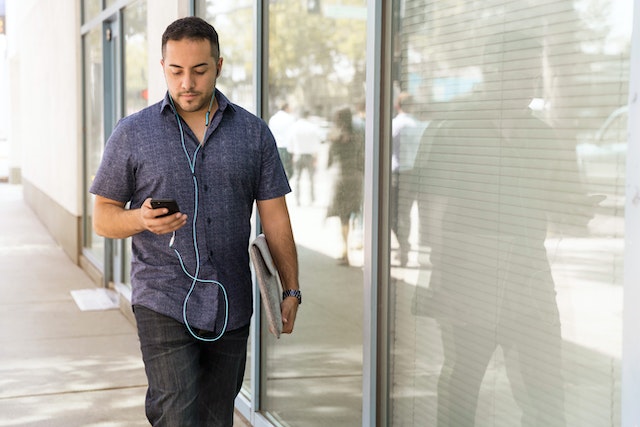Most of us know that moving and exercising more during the day is good for our health, but struggle to get out of the chair when we’re ensconced in work. In this post, Rosie Tate suggests five ways we can move more and sit less.
There are no two ways about it: the work of an editor involves a lot of sitting down. But as much as we may love our work, a sedentary lifestyle isn’t good for our physical or mental health. Human beings evolved to move – to walk, run and rest in positions like squatting that don’t involve sitting on a chair in the exact same position for hours on end.
Numerous studies have shown that we should sit less and move more. While sitting for long periods has been linked to being overweight, type 2 diabetes and some types of cancer, this can be offset by doing more exercise. A recent study shows that one in 10 early deaths could be avoided globally if everyone did just 75 minutes of exercise per week. Not only is exercise essential for our health but it also makes us feel good. Who doesn’t feel better after a walk, a run or a workout? Movement is one of the pillars of wellbeing and happiness. In this post, I suggest five ways to move more during your working day.
1. Have a movement break every hour
It’s easy to get so absorbed in our work that we spend hours in the same sitting position – often hunched over a screen. If your work involves sitting down all day, take a movement break every hour. Walk around the block, or if timings don’t allow for this, take a few steps in your workplace. Do a few stretches, squats, push-ups, sit-ups or star jumps, dance to a favourite track or move in any other way that makes you feel good. Even just one minute of movement away from your screen every hour can make a world of difference.
2. Shift positions while working
Whether we’re working, eating, watching TV, reading or travelling, we are usually sitting down. In Western countries – unlike in some other countries that favour squatting or sitting on the floor – sitting on a chair is the default resting position. It’s worth trying to switch rest positions, as sitting in a chair for long periods of time places strain on our back and pelvis and, over time, can lead to bad posture or repetitive strain injury. Try to switch positions throughout the day. Here are some ideas to get you started:
- Use a standing desk to alternate between sitting and standing. Standing desks don’t have to be expensive: you can improvise one (search online for ideas) or buy a standing desk converter that sits on top of your regular desk.
- Try squatting! This improves ankle mobility and gives your back a break from sitting. Try it for a few minutes a day and then extend it to longer periods.
- Put your laptop on a coffee table and sit on the floor.
- While sitting in a chair, try doing some chair yoga exercises.
3. Walk and talk
Meetings can be a great opportunity to incorporate movement into your day because it’s possible to ‘walk and talk’ rather than ‘sit and talk’. Granted, some meetings may not lend themselves to walking. If we’re talking to a client and they ask us to look at a convoluted sentence on page 37, we’d rather not be strolling through a local park.
But we can look out for meetings where we don’t need to be glued to our screens and take the opportunity to step outside. If there’s an agenda for the meeting, you could have this on your phone and refer to it when needed. This is a great opportunity to get some sunshine – or if it isn’t shining, some natural light at least – which leads to better sleep, boosts vitamin D levels and regulates hormones. Jean-Jacques Rousseau wrote in his Confessions: ‘Walking has something in it which animates and heightens my ideas: I can scarcely think when I stay in one place; my body must be set a-going if my mind is to work.’ Who knows? You might find that your most productive talks happen while you’re walking.
4. Move more
Often, we see movement as something that must be done within a specific time frame and called ‘exercise’. We set time aside for our daily or weekly sessions and we don’t move very much the rest of the time. In reality, we don’t need a designated exercise session to move more. Movement can be incorporated into our daily activities if we look for opportunities to do so. And when we start looking, the opportunities abound. Here are some ideas.
- Take the stairs instead of the lift or escalators.
- Where possible, walk or cycle instead of taking public transport.
- While watching TV, do some gentle exercises or stretches. There are plenty that you can do while still looking at the screen – a quick online search offers plenty of inspiration.
- Try using text-to-speech software to move around or stretch while listening to text instead of sitting down to read it, such as blog posts, long emails or even perhaps the first read-through of a developmental edit.
- Stand while on public transport instead of sitting down.
You can also use your lunch break to move more. Try eating mindfully while walking or doing an online exercise class (the Better at Home app offers hundreds of free online classes for all levels).
5. Get into and stick to good habits
The most crucial point of all when it comes to working movement into your day is to get into – and stick to – good habits. As anyone who has ever set new year’s resolutions knows, it’s all too easy to start with the best of intentions but fail to put them into practice. In his book Atomic Habits, James Clear gives lots of tips on how to make good habits stick. A couple that stuck with me after reading his book:
- Use the ‘two-minute rule’: you can break down habits into small tasks that fit into two minutes or less. When trying to move more during the day, you could start by doing this in one of the ways listed above for just two minutes each day. Do this for one week and work your way up to longer periods from there.
- Make the habit obvious by using cues. If you want to spend some time at a standing desk each day, make sure it is set up so that you’re more likely to use it. Set an alarm to take a movement break each hour. Leave your yoga mat out in plain sight if you’re planning a lunchtime session on your mat.
You don’t need to make drastic changes: incremental steps will do just fine. Start small and work movement into your day little by little over the course of a few weeks. Even a few more minutes of physical activity and varied movement a day can make a huge difference in the long run. By building this movement into your day – moving more and sitting less – you should get to the end of the year feeling a bit more energetic and less achy without having put aside long periods of time each day specifically for exercise.
I’d love to hear your thoughts or other suggestions on how to move more in the comments below.
About Rosie Tate
Rosie Tate is co-founder of Tate & Clayburn, a London-based company that offers editorial and language services to clients worldwide. A first-class Oxford University languages graduate with an MA in Documentary Filmmaking, she’s an experienced editor, writer and producer, having worked for Oxford University Press, the BBC and Save the Children.
 About the CIEP
About the CIEP
The Chartered Institute of Editing and Proofreading (CIEP) is a non-profit body promoting excellence in English language editing. We set and demonstrate editorial standards, and we are a community, training hub and support network for editorial professionals – the people who work to make text accurate, clear and fit for purpose.
Find out more about:
Photo credits: header image by Karolina Grabowska on Pexels, man walking outside on a call by LinkedIn Sales Navigator on Pexels.
Posted by Eleanor Smith, blog assistant.
The views expressed here do not necessarily reflect those of the CIEP.




